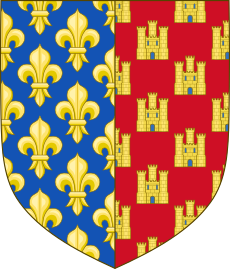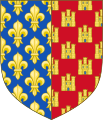Alphonse, Count of Poitiers facts for kids

Alphonse (born 11 November 1220 – died 21 August 1271) was an important French noble. He was the count of Poitou from 1225 and the count of Toulouse from 1249. As the Count of Toulouse, he also ruled the area known as the Marquisate of Provence. He was a key figure in France during the 13th century.
Contents
Becoming a Count: Alphonse's Early Life
Alphonse was born in Poissy, France. His parents were King Louis VIII of France and Blanche of Castile. He was the younger brother of King Louis IX of France, who later became known as Saint Louis. He also had an older brother, Charles I of Anjou.
In 1229, Alphonse's mother, Blanche of Castile, was ruling France while her son, King Louis IX, was young. She made a peace agreement called the Treaty of Paris with Raymond VII, Count of Toulouse. This treaty said that a brother of King Louis would marry Raymond VII's daughter, Joan. So, in 1237, Alphonse married Joan. Since Joan was Raymond's only child, Alphonse and Joan became the rulers of Toulouse when Raymond died in 1249.
Alphonse also received lands in Poitou and Auvergne from his father's will. These lands were given to him as an appanage, which means they were a gift of land and income from the king to a royal family member. To help Alphonse keep these lands, King Louis IX fought and won the battle of Taillebourg in the Saintonge War. This battle was against a revolt that was supported by King Henry III of England.
Alphonse Joins the Crusades
Alphonse went on two Crusades with his brother, King Louis IX. The first was the Seventh Crusade in 1248, and the second was the Eighth Crusade in 1270.
For the Seventh Crusade, Alphonse gathered a lot of money and many soldiers. He arrived in Damietta on 24 October 1249, after the city had already been captured. He left to go home on 10 August 1250. While he was away, his father-in-law died. So, Alphonse went straight to Toulouse to take control of his new lands. There was some resistance from people who didn't want him to be count, but his mother, Blanche of Castile, helped him settle things. She was ruling France at the time because King Louis IX was still away on the Crusade.
Alphonse's Later Years and Rule
In 1252, after his mother, Blanche of Castile, passed away, Alphonse became a joint ruler of France with Charles of Anjou. They ruled until King Louis IX returned from the Crusade. During this time, Alphonse played a big part in the talks and agreements that led to the Treaty of Paris in 1259. This treaty was important because King Henry III of England agreed that he had lost lands in France, like Normandy and Poitou. In return, France stopped supporting English rebels.

Even though he went on Crusades, Alphonse mostly stayed in Paris. He managed his lands through officials and inspectors. He worked hard to fix problems in his own lands that had been caused by past conflicts. He also started to organize the way his lands were managed, which helped prepare them to become part of the French kingdom later on.
When King Louis IX started the Eighth Crusade, Alphonse once again raised a lot of money and went with his brother. However, Alphonse did not make it back to France. He died on his way home in Savona, Italy, on 21 August 1271.
Alphonse's Death and What Happened Next
Alphonse died without any children. This raised questions about who would inherit his lands. One idea was that his lands should go back to the king. Another idea was that they should be given to his family members. Charles of Anjou claimed the lands. However, in 1283, the French high court, called the Parlement, decided that the County of Toulouse should go back to the king if there were no male heirs.
Alphonse's wife, Joan, died just four days after him. She had tried to give away some of her inherited lands in her will. Joan was the only child of Raymond VII, Count of Toulouse, so by law, her lands should have gone to her closest male relative. But, the Parlement said her will was not valid in 1274.
However, one specific gift in Alphonse's will was allowed. He gave his wife's lands in the Comtat Venaissin to the Holy See (the Pope). This area became a Papal territory and remained under the Pope's rule until 1791.
See also
 In Spanish: Alfonso de Poitiers para niños
In Spanish: Alfonso de Poitiers para niños
- Abraham of Aragon
Images for kids
-
Alphonse, as Count of Toulouse, recognised the autonomy of the commune of the town of Agen. In this illustration he takes an oath before the consuls with his right hand on the town ordinances, while sitting on a pedestal. The consul administering the oath is forced to go on his knees, symbolising Alphonse's lordship and the town's loyalty.
-
Alphonse's coat of arms was formed of those of France (left) and Castile (right), representing his father and mother respectively: Per pale azure semé-de-lis or dimidiating gules semé of castles or
| Regnal titles | ||
|---|---|---|
| Vacant
Title last held by
John Lackland |
Count of Poitiers 1225–1271 |
Vacant
Title next held by
Philip the Tall |
| Preceded by Raymond VII |
Count of Toulouse 1249–1271 With: Joan |
Vacant
Royal domain
|



